Common Biases in Decision Making
VerifiedAdded on 2019/10/31
|12
|3132
|259
Essay
AI Summary
This essay examines common biases in managerial decision-making, including selective perception, confirmation bias, first impression bias, recency bias, stereotype bias, and spillover bias. It explains how these biases stem from cognitive shortcuts and heuristics, potentially skewing the reliability of evidence used in decision-making. The essay then proposes strategies to mitigate these biases, such as seeking diverse perspectives, challenging existing beliefs, and focusing on failures alongside successes. It emphasizes the importance of critical thinking and awareness of one's own biases in making sound business decisions. The conclusion highlights the pervasive nature of biases and the need for managers to actively work towards fairer and more objective judgments.
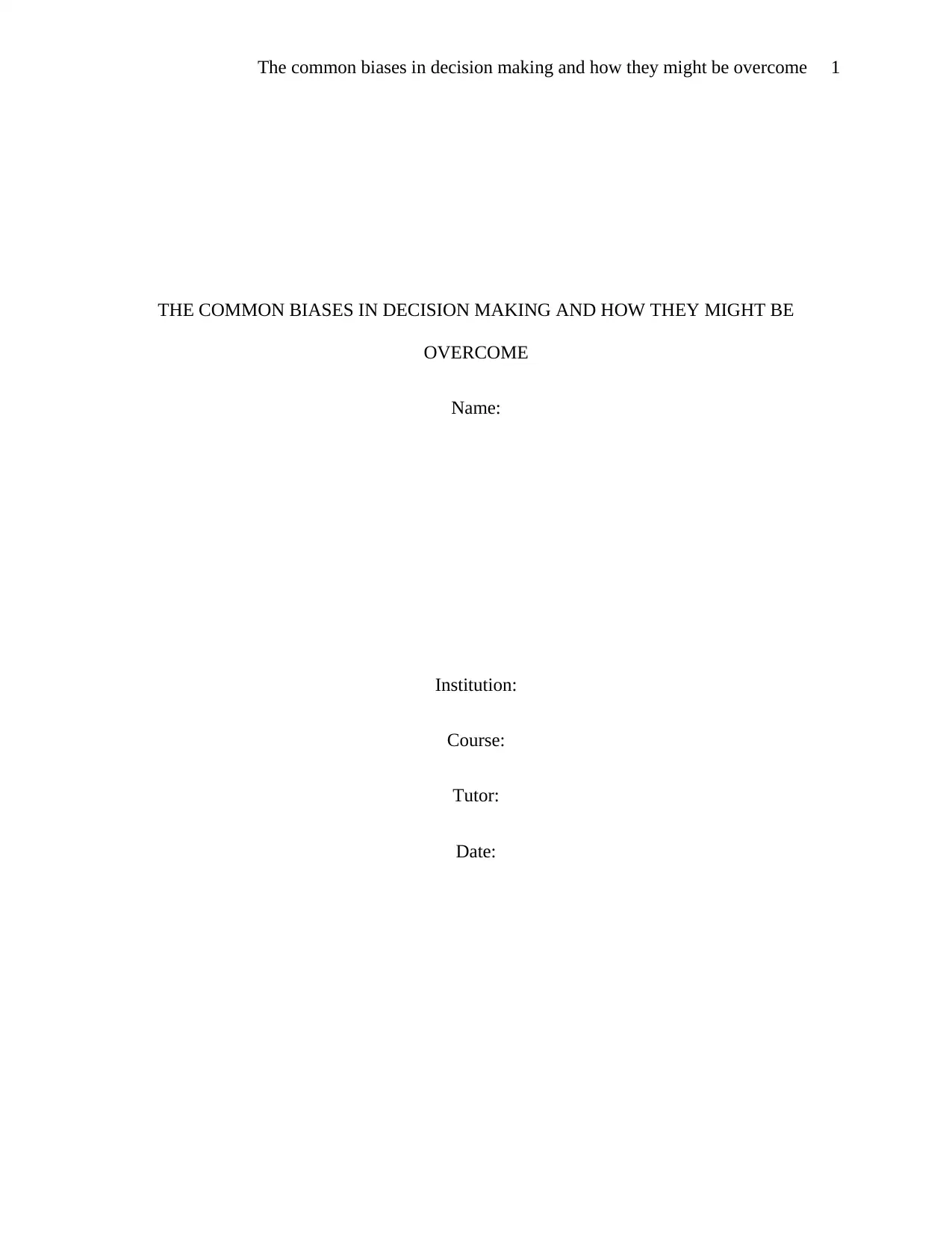
The common biases in decision making and how they might be overcome 1
THE COMMON BIASES IN DECISION MAKING AND HOW THEY MIGHT BE
OVERCOME
Name:
Institution:
Course:
Tutor:
Date:
THE COMMON BIASES IN DECISION MAKING AND HOW THEY MIGHT BE
OVERCOME
Name:
Institution:
Course:
Tutor:
Date:
Paraphrase This Document
Need a fresh take? Get an instant paraphrase of this document with our AI Paraphraser
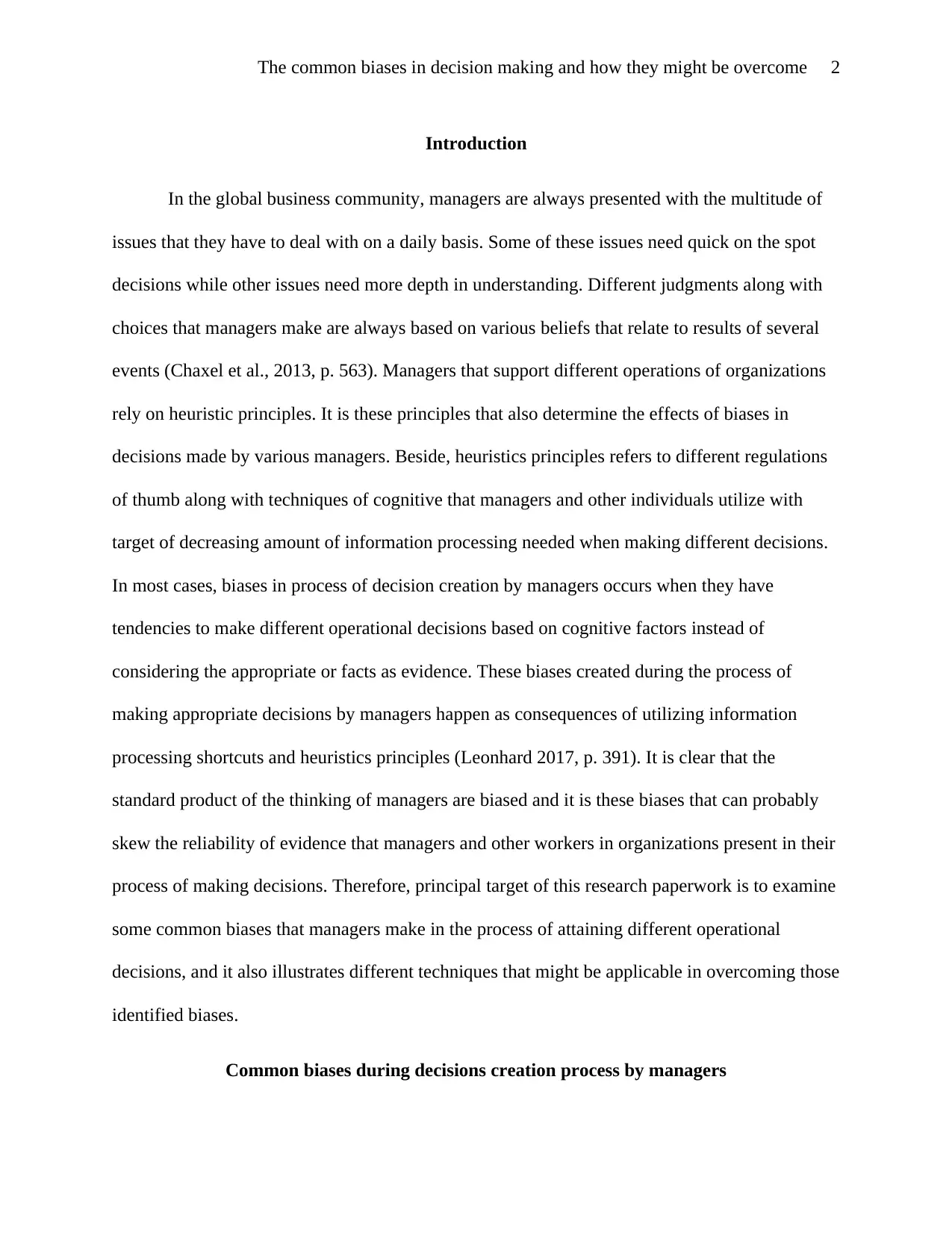
The common biases in decision making and how they might be overcome 2
Introduction
In the global business community, managers are always presented with the multitude of
issues that they have to deal with on a daily basis. Some of these issues need quick on the spot
decisions while other issues need more depth in understanding. Different judgments along with
choices that managers make are always based on various beliefs that relate to results of several
events (Chaxel et al., 2013, p. 563). Managers that support different operations of organizations
rely on heuristic principles. It is these principles that also determine the effects of biases in
decisions made by various managers. Beside, heuristics principles refers to different regulations
of thumb along with techniques of cognitive that managers and other individuals utilize with
target of decreasing amount of information processing needed when making different decisions.
In most cases, biases in process of decision creation by managers occurs when they have
tendencies to make different operational decisions based on cognitive factors instead of
considering the appropriate or facts as evidence. These biases created during the process of
making appropriate decisions by managers happen as consequences of utilizing information
processing shortcuts and heuristics principles (Leonhard 2017, p. 391). It is clear that the
standard product of the thinking of managers are biased and it is these biases that can probably
skew the reliability of evidence that managers and other workers in organizations present in their
process of making decisions. Therefore, principal target of this research paperwork is to examine
some common biases that managers make in the process of attaining different operational
decisions, and it also illustrates different techniques that might be applicable in overcoming those
identified biases.
Common biases during decisions creation process by managers
Introduction
In the global business community, managers are always presented with the multitude of
issues that they have to deal with on a daily basis. Some of these issues need quick on the spot
decisions while other issues need more depth in understanding. Different judgments along with
choices that managers make are always based on various beliefs that relate to results of several
events (Chaxel et al., 2013, p. 563). Managers that support different operations of organizations
rely on heuristic principles. It is these principles that also determine the effects of biases in
decisions made by various managers. Beside, heuristics principles refers to different regulations
of thumb along with techniques of cognitive that managers and other individuals utilize with
target of decreasing amount of information processing needed when making different decisions.
In most cases, biases in process of decision creation by managers occurs when they have
tendencies to make different operational decisions based on cognitive factors instead of
considering the appropriate or facts as evidence. These biases created during the process of
making appropriate decisions by managers happen as consequences of utilizing information
processing shortcuts and heuristics principles (Leonhard 2017, p. 391). It is clear that the
standard product of the thinking of managers are biased and it is these biases that can probably
skew the reliability of evidence that managers and other workers in organizations present in their
process of making decisions. Therefore, principal target of this research paperwork is to examine
some common biases that managers make in the process of attaining different operational
decisions, and it also illustrates different techniques that might be applicable in overcoming those
identified biases.
Common biases during decisions creation process by managers
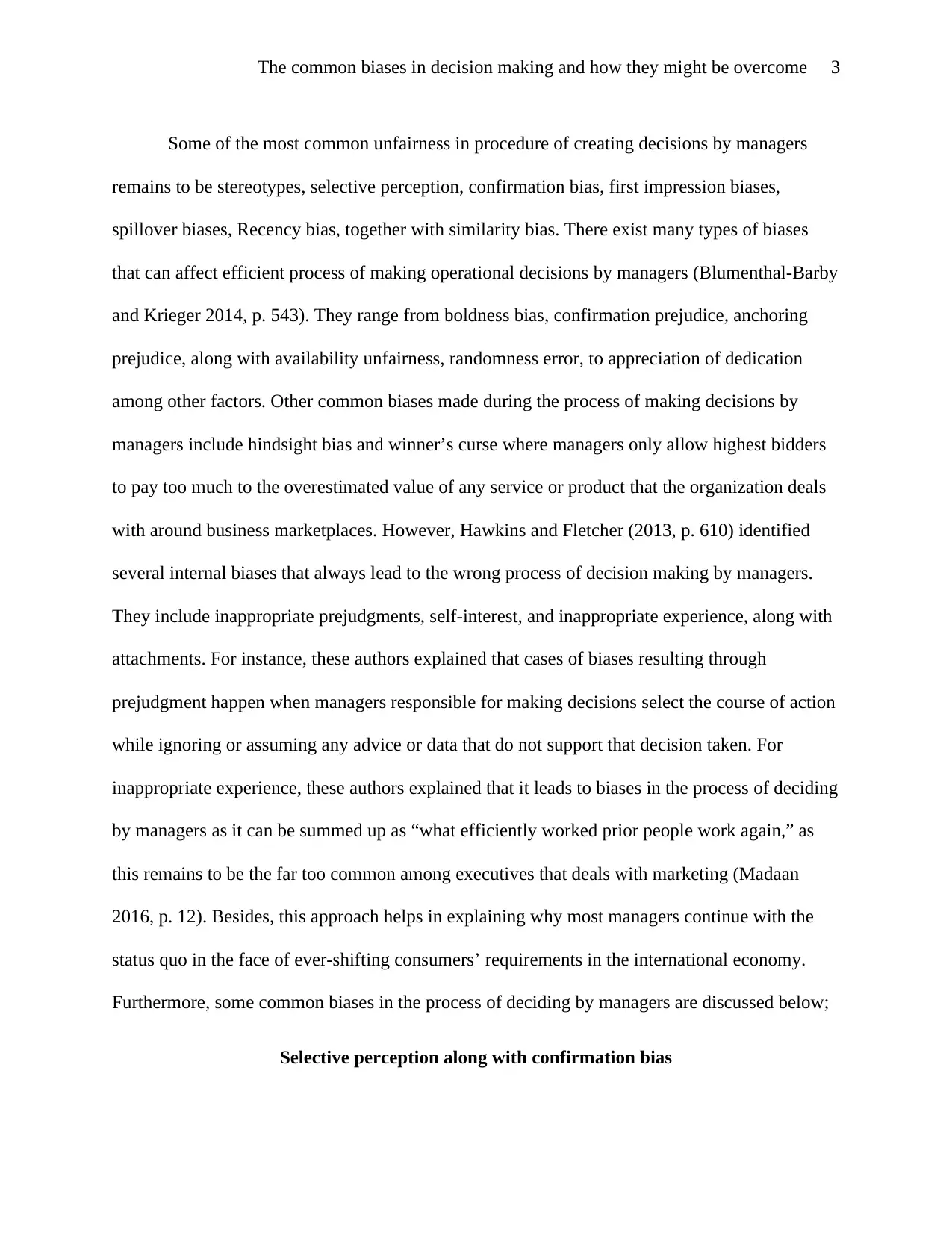
The common biases in decision making and how they might be overcome 3
Some of the most common unfairness in procedure of creating decisions by managers
remains to be stereotypes, selective perception, confirmation bias, first impression biases,
spillover biases, Recency bias, together with similarity bias. There exist many types of biases
that can affect efficient process of making operational decisions by managers (Blumenthal-Barby
and Krieger 2014, p. 543). They range from boldness bias, confirmation prejudice, anchoring
prejudice, along with availability unfairness, randomness error, to appreciation of dedication
among other factors. Other common biases made during the process of making decisions by
managers include hindsight bias and winner’s curse where managers only allow highest bidders
to pay too much to the overestimated value of any service or product that the organization deals
with around business marketplaces. However, Hawkins and Fletcher (2013, p. 610) identified
several internal biases that always lead to the wrong process of decision making by managers.
They include inappropriate prejudgments, self-interest, and inappropriate experience, along with
attachments. For instance, these authors explained that cases of biases resulting through
prejudgment happen when managers responsible for making decisions select the course of action
while ignoring or assuming any advice or data that do not support that decision taken. For
inappropriate experience, these authors explained that it leads to biases in the process of deciding
by managers as it can be summed up as “what efficiently worked prior people work again,” as
this remains to be the far too common among executives that deals with marketing (Madaan
2016, p. 12). Besides, this approach helps in explaining why most managers continue with the
status quo in the face of ever-shifting consumers’ requirements in the international economy.
Furthermore, some common biases in the process of deciding by managers are discussed below;
Selective perception along with confirmation bias
Some of the most common unfairness in procedure of creating decisions by managers
remains to be stereotypes, selective perception, confirmation bias, first impression biases,
spillover biases, Recency bias, together with similarity bias. There exist many types of biases
that can affect efficient process of making operational decisions by managers (Blumenthal-Barby
and Krieger 2014, p. 543). They range from boldness bias, confirmation prejudice, anchoring
prejudice, along with availability unfairness, randomness error, to appreciation of dedication
among other factors. Other common biases made during the process of making decisions by
managers include hindsight bias and winner’s curse where managers only allow highest bidders
to pay too much to the overestimated value of any service or product that the organization deals
with around business marketplaces. However, Hawkins and Fletcher (2013, p. 610) identified
several internal biases that always lead to the wrong process of decision making by managers.
They include inappropriate prejudgments, self-interest, and inappropriate experience, along with
attachments. For instance, these authors explained that cases of biases resulting through
prejudgment happen when managers responsible for making decisions select the course of action
while ignoring or assuming any advice or data that do not support that decision taken. For
inappropriate experience, these authors explained that it leads to biases in the process of deciding
by managers as it can be summed up as “what efficiently worked prior people work again,” as
this remains to be the far too common among executives that deals with marketing (Madaan
2016, p. 12). Besides, this approach helps in explaining why most managers continue with the
status quo in the face of ever-shifting consumers’ requirements in the international economy.
Furthermore, some common biases in the process of deciding by managers are discussed below;
Selective perception along with confirmation bias
⊘ This is a preview!⊘
Do you want full access?
Subscribe today to unlock all pages.

Trusted by 1+ million students worldwide
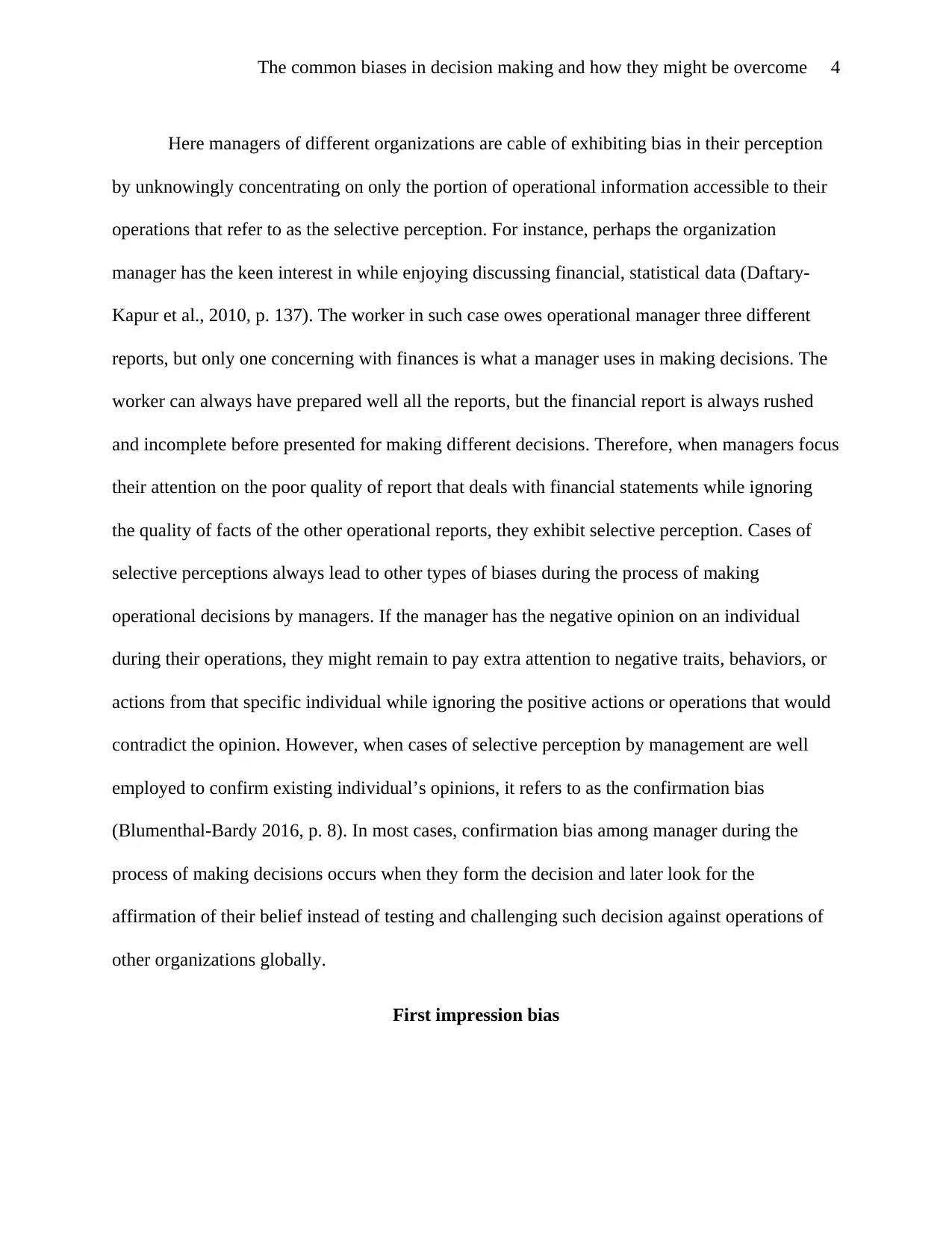
The common biases in decision making and how they might be overcome 4
Here managers of different organizations are cable of exhibiting bias in their perception
by unknowingly concentrating on only the portion of operational information accessible to their
operations that refer to as the selective perception. For instance, perhaps the organization
manager has the keen interest in while enjoying discussing financial, statistical data (Daftary-
Kapur et al., 2010, p. 137). The worker in such case owes operational manager three different
reports, but only one concerning with finances is what a manager uses in making decisions. The
worker can always have prepared well all the reports, but the financial report is always rushed
and incomplete before presented for making different decisions. Therefore, when managers focus
their attention on the poor quality of report that deals with financial statements while ignoring
the quality of facts of the other operational reports, they exhibit selective perception. Cases of
selective perceptions always lead to other types of biases during the process of making
operational decisions by managers. If the manager has the negative opinion on an individual
during their operations, they might remain to pay extra attention to negative traits, behaviors, or
actions from that specific individual while ignoring the positive actions or operations that would
contradict the opinion. However, when cases of selective perception by management are well
employed to confirm existing individual’s opinions, it refers to as the confirmation bias
(Blumenthal-Bardy 2016, p. 8). In most cases, confirmation bias among manager during the
process of making decisions occurs when they form the decision and later look for the
affirmation of their belief instead of testing and challenging such decision against operations of
other organizations globally.
First impression bias
Here managers of different organizations are cable of exhibiting bias in their perception
by unknowingly concentrating on only the portion of operational information accessible to their
operations that refer to as the selective perception. For instance, perhaps the organization
manager has the keen interest in while enjoying discussing financial, statistical data (Daftary-
Kapur et al., 2010, p. 137). The worker in such case owes operational manager three different
reports, but only one concerning with finances is what a manager uses in making decisions. The
worker can always have prepared well all the reports, but the financial report is always rushed
and incomplete before presented for making different decisions. Therefore, when managers focus
their attention on the poor quality of report that deals with financial statements while ignoring
the quality of facts of the other operational reports, they exhibit selective perception. Cases of
selective perceptions always lead to other types of biases during the process of making
operational decisions by managers. If the manager has the negative opinion on an individual
during their operations, they might remain to pay extra attention to negative traits, behaviors, or
actions from that specific individual while ignoring the positive actions or operations that would
contradict the opinion. However, when cases of selective perception by management are well
employed to confirm existing individual’s opinions, it refers to as the confirmation bias
(Blumenthal-Bardy 2016, p. 8). In most cases, confirmation bias among manager during the
process of making decisions occurs when they form the decision and later look for the
affirmation of their belief instead of testing and challenging such decision against operations of
other organizations globally.
First impression bias
Paraphrase This Document
Need a fresh take? Get an instant paraphrase of this document with our AI Paraphraser
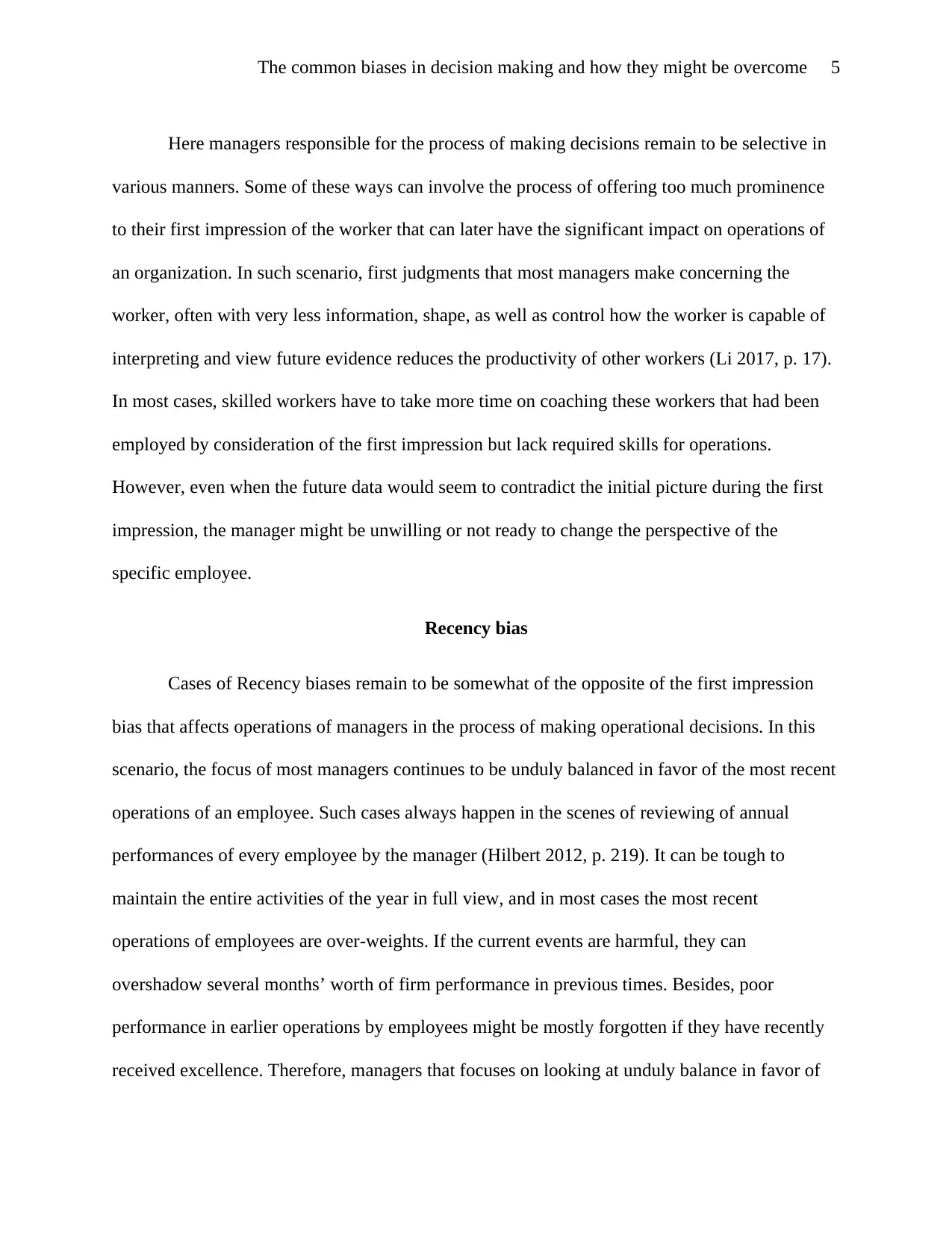
The common biases in decision making and how they might be overcome 5
Here managers responsible for the process of making decisions remain to be selective in
various manners. Some of these ways can involve the process of offering too much prominence
to their first impression of the worker that can later have the significant impact on operations of
an organization. In such scenario, first judgments that most managers make concerning the
worker, often with very less information, shape, as well as control how the worker is capable of
interpreting and view future evidence reduces the productivity of other workers (Li 2017, p. 17).
In most cases, skilled workers have to take more time on coaching these workers that had been
employed by consideration of the first impression but lack required skills for operations.
However, even when the future data would seem to contradict the initial picture during the first
impression, the manager might be unwilling or not ready to change the perspective of the
specific employee.
Recency bias
Cases of Recency biases remain to be somewhat of the opposite of the first impression
bias that affects operations of managers in the process of making operational decisions. In this
scenario, the focus of most managers continues to be unduly balanced in favor of the most recent
operations of an employee. Such cases always happen in the scenes of reviewing of annual
performances of every employee by the manager (Hilbert 2012, p. 219). It can be tough to
maintain the entire activities of the year in full view, and in most cases the most recent
operations of employees are over-weights. If the current events are harmful, they can
overshadow several months’ worth of firm performance in previous times. Besides, poor
performance in earlier operations by employees might be mostly forgotten if they have recently
received excellence. Therefore, managers that focuses on looking at unduly balance in favor of
Here managers responsible for the process of making decisions remain to be selective in
various manners. Some of these ways can involve the process of offering too much prominence
to their first impression of the worker that can later have the significant impact on operations of
an organization. In such scenario, first judgments that most managers make concerning the
worker, often with very less information, shape, as well as control how the worker is capable of
interpreting and view future evidence reduces the productivity of other workers (Li 2017, p. 17).
In most cases, skilled workers have to take more time on coaching these workers that had been
employed by consideration of the first impression but lack required skills for operations.
However, even when the future data would seem to contradict the initial picture during the first
impression, the manager might be unwilling or not ready to change the perspective of the
specific employee.
Recency bias
Cases of Recency biases remain to be somewhat of the opposite of the first impression
bias that affects operations of managers in the process of making operational decisions. In this
scenario, the focus of most managers continues to be unduly balanced in favor of the most recent
operations of an employee. Such cases always happen in the scenes of reviewing of annual
performances of every employee by the manager (Hilbert 2012, p. 219). It can be tough to
maintain the entire activities of the year in full view, and in most cases the most recent
operations of employees are over-weights. If the current events are harmful, they can
overshadow several months’ worth of firm performance in previous times. Besides, poor
performance in earlier operations by employees might be mostly forgotten if they have recently
received excellence. Therefore, managers that focuses on looking at unduly balance in favor of
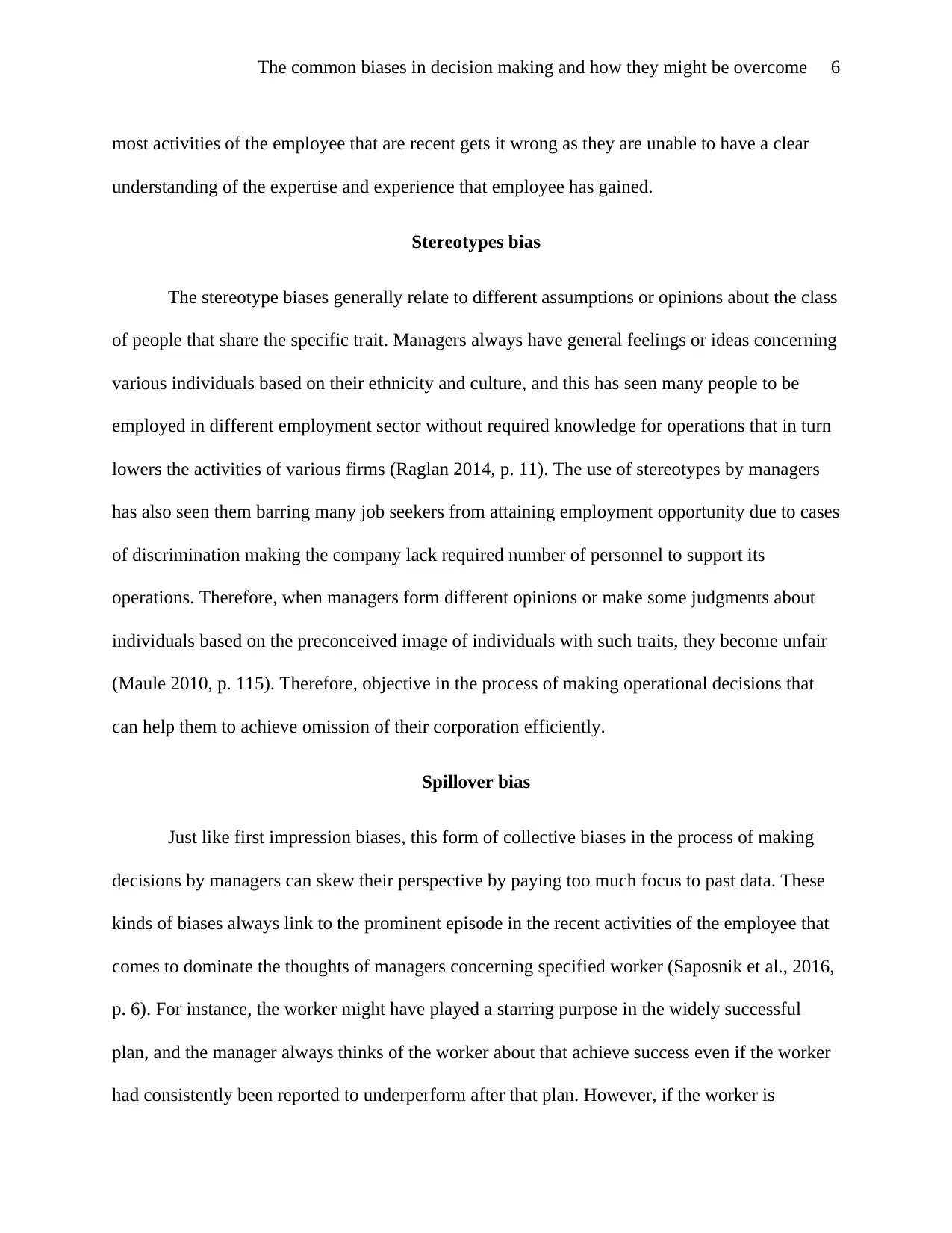
The common biases in decision making and how they might be overcome 6
most activities of the employee that are recent gets it wrong as they are unable to have a clear
understanding of the expertise and experience that employee has gained.
Stereotypes bias
The stereotype biases generally relate to different assumptions or opinions about the class
of people that share the specific trait. Managers always have general feelings or ideas concerning
various individuals based on their ethnicity and culture, and this has seen many people to be
employed in different employment sector without required knowledge for operations that in turn
lowers the activities of various firms (Raglan 2014, p. 11). The use of stereotypes by managers
has also seen them barring many job seekers from attaining employment opportunity due to cases
of discrimination making the company lack required number of personnel to support its
operations. Therefore, when managers form different opinions or make some judgments about
individuals based on the preconceived image of individuals with such traits, they become unfair
(Maule 2010, p. 115). Therefore, objective in the process of making operational decisions that
can help them to achieve omission of their corporation efficiently.
Spillover bias
Just like first impression biases, this form of collective biases in the process of making
decisions by managers can skew their perspective by paying too much focus to past data. These
kinds of biases always link to the prominent episode in the recent activities of the employee that
comes to dominate the thoughts of managers concerning specified worker (Saposnik et al., 2016,
p. 6). For instance, the worker might have played a starring purpose in the widely successful
plan, and the manager always thinks of the worker about that achieve success even if the worker
had consistently been reported to underperform after that plan. However, if the worker is
most activities of the employee that are recent gets it wrong as they are unable to have a clear
understanding of the expertise and experience that employee has gained.
Stereotypes bias
The stereotype biases generally relate to different assumptions or opinions about the class
of people that share the specific trait. Managers always have general feelings or ideas concerning
various individuals based on their ethnicity and culture, and this has seen many people to be
employed in different employment sector without required knowledge for operations that in turn
lowers the activities of various firms (Raglan 2014, p. 11). The use of stereotypes by managers
has also seen them barring many job seekers from attaining employment opportunity due to cases
of discrimination making the company lack required number of personnel to support its
operations. Therefore, when managers form different opinions or make some judgments about
individuals based on the preconceived image of individuals with such traits, they become unfair
(Maule 2010, p. 115). Therefore, objective in the process of making operational decisions that
can help them to achieve omission of their corporation efficiently.
Spillover bias
Just like first impression biases, this form of collective biases in the process of making
decisions by managers can skew their perspective by paying too much focus to past data. These
kinds of biases always link to the prominent episode in the recent activities of the employee that
comes to dominate the thoughts of managers concerning specified worker (Saposnik et al., 2016,
p. 6). For instance, the worker might have played a starring purpose in the widely successful
plan, and the manager always thinks of the worker about that achieve success even if the worker
had consistently been reported to underperform after that plan. However, if the worker is
⊘ This is a preview!⊘
Do you want full access?
Subscribe today to unlock all pages.

Trusted by 1+ million students worldwide
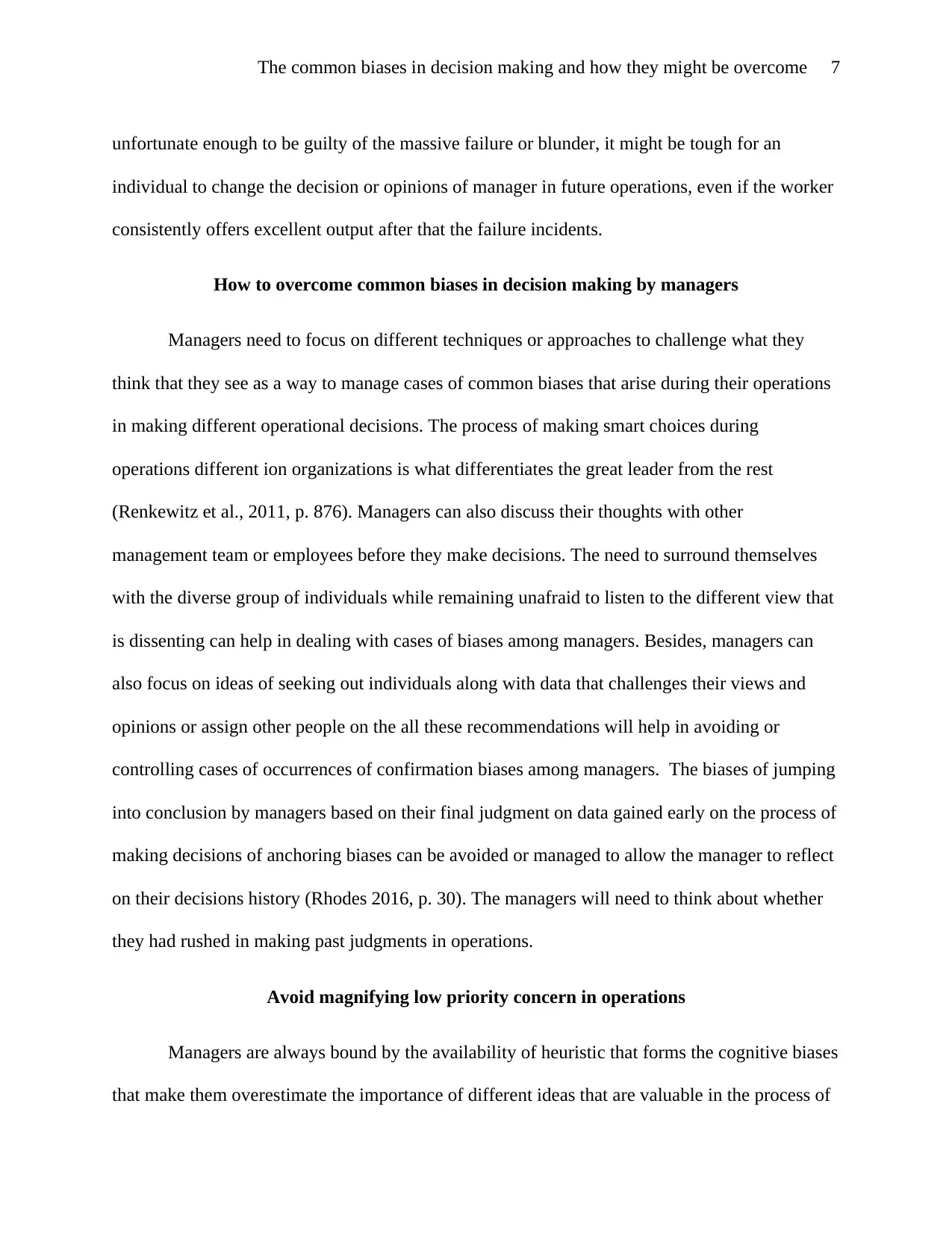
The common biases in decision making and how they might be overcome 7
unfortunate enough to be guilty of the massive failure or blunder, it might be tough for an
individual to change the decision or opinions of manager in future operations, even if the worker
consistently offers excellent output after that the failure incidents.
How to overcome common biases in decision making by managers
Managers need to focus on different techniques or approaches to challenge what they
think that they see as a way to manage cases of common biases that arise during their operations
in making different operational decisions. The process of making smart choices during
operations different ion organizations is what differentiates the great leader from the rest
(Renkewitz et al., 2011, p. 876). Managers can also discuss their thoughts with other
management team or employees before they make decisions. The need to surround themselves
with the diverse group of individuals while remaining unafraid to listen to the different view that
is dissenting can help in dealing with cases of biases among managers. Besides, managers can
also focus on ideas of seeking out individuals along with data that challenges their views and
opinions or assign other people on the all these recommendations will help in avoiding or
controlling cases of occurrences of confirmation biases among managers. The biases of jumping
into conclusion by managers based on their final judgment on data gained early on the process of
making decisions of anchoring biases can be avoided or managed to allow the manager to reflect
on their decisions history (Rhodes 2016, p. 30). The managers will need to think about whether
they had rushed in making past judgments in operations.
Avoid magnifying low priority concern in operations
Managers are always bound by the availability of heuristic that forms the cognitive biases
that make them overestimate the importance of different ideas that are valuable in the process of
unfortunate enough to be guilty of the massive failure or blunder, it might be tough for an
individual to change the decision or opinions of manager in future operations, even if the worker
consistently offers excellent output after that the failure incidents.
How to overcome common biases in decision making by managers
Managers need to focus on different techniques or approaches to challenge what they
think that they see as a way to manage cases of common biases that arise during their operations
in making different operational decisions. The process of making smart choices during
operations different ion organizations is what differentiates the great leader from the rest
(Renkewitz et al., 2011, p. 876). Managers can also discuss their thoughts with other
management team or employees before they make decisions. The need to surround themselves
with the diverse group of individuals while remaining unafraid to listen to the different view that
is dissenting can help in dealing with cases of biases among managers. Besides, managers can
also focus on ideas of seeking out individuals along with data that challenges their views and
opinions or assign other people on the all these recommendations will help in avoiding or
controlling cases of occurrences of confirmation biases among managers. The biases of jumping
into conclusion by managers based on their final judgment on data gained early on the process of
making decisions of anchoring biases can be avoided or managed to allow the manager to reflect
on their decisions history (Rhodes 2016, p. 30). The managers will need to think about whether
they had rushed in making past judgments in operations.
Avoid magnifying low priority concern in operations
Managers are always bound by the availability of heuristic that forms the cognitive biases
that make them overestimate the importance of different ideas that are valuable in the process of
Paraphrase This Document
Need a fresh take? Get an instant paraphrase of this document with our AI Paraphraser
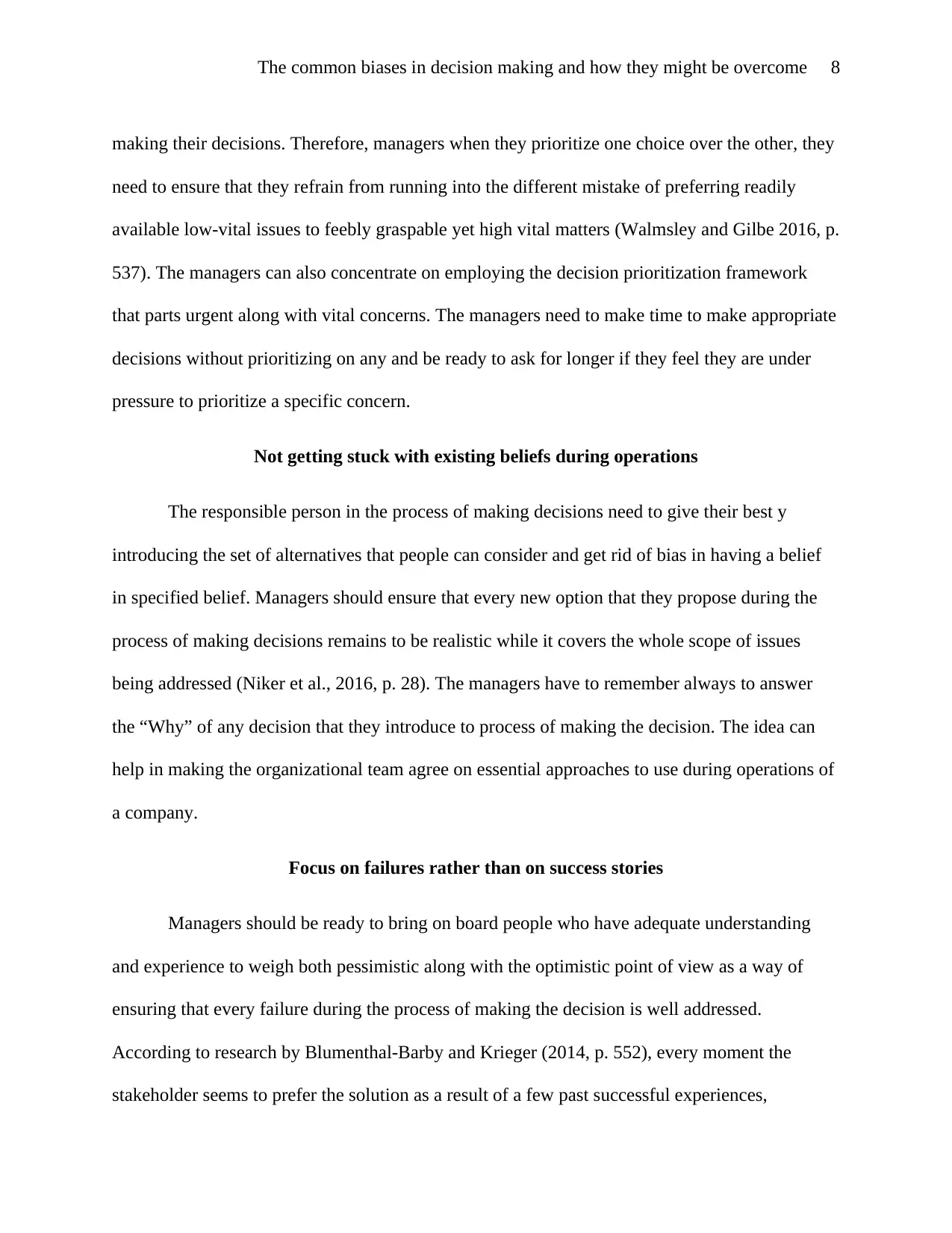
The common biases in decision making and how they might be overcome 8
making their decisions. Therefore, managers when they prioritize one choice over the other, they
need to ensure that they refrain from running into the different mistake of preferring readily
available low-vital issues to feebly graspable yet high vital matters (Walmsley and Gilbe 2016, p.
537). The managers can also concentrate on employing the decision prioritization framework
that parts urgent along with vital concerns. The managers need to make time to make appropriate
decisions without prioritizing on any and be ready to ask for longer if they feel they are under
pressure to prioritize a specific concern.
Not getting stuck with existing beliefs during operations
The responsible person in the process of making decisions need to give their best y
introducing the set of alternatives that people can consider and get rid of bias in having a belief
in specified belief. Managers should ensure that every new option that they propose during the
process of making decisions remains to be realistic while it covers the whole scope of issues
being addressed (Niker et al., 2016, p. 28). The managers have to remember always to answer
the “Why” of any decision that they introduce to process of making the decision. The idea can
help in making the organizational team agree on essential approaches to use during operations of
a company.
Focus on failures rather than on success stories
Managers should be ready to bring on board people who have adequate understanding
and experience to weigh both pessimistic along with the optimistic point of view as a way of
ensuring that every failure during the process of making the decision is well addressed.
According to research by Blumenthal-Barby and Krieger (2014, p. 552), every moment the
stakeholder seems to prefer the solution as a result of a few past successful experiences,
making their decisions. Therefore, managers when they prioritize one choice over the other, they
need to ensure that they refrain from running into the different mistake of preferring readily
available low-vital issues to feebly graspable yet high vital matters (Walmsley and Gilbe 2016, p.
537). The managers can also concentrate on employing the decision prioritization framework
that parts urgent along with vital concerns. The managers need to make time to make appropriate
decisions without prioritizing on any and be ready to ask for longer if they feel they are under
pressure to prioritize a specific concern.
Not getting stuck with existing beliefs during operations
The responsible person in the process of making decisions need to give their best y
introducing the set of alternatives that people can consider and get rid of bias in having a belief
in specified belief. Managers should ensure that every new option that they propose during the
process of making decisions remains to be realistic while it covers the whole scope of issues
being addressed (Niker et al., 2016, p. 28). The managers have to remember always to answer
the “Why” of any decision that they introduce to process of making the decision. The idea can
help in making the organizational team agree on essential approaches to use during operations of
a company.
Focus on failures rather than on success stories
Managers should be ready to bring on board people who have adequate understanding
and experience to weigh both pessimistic along with the optimistic point of view as a way of
ensuring that every failure during the process of making the decision is well addressed.
According to research by Blumenthal-Barby and Krieger (2014, p. 552), every moment the
stakeholder seems to prefer the solution as a result of a few past successful experiences,
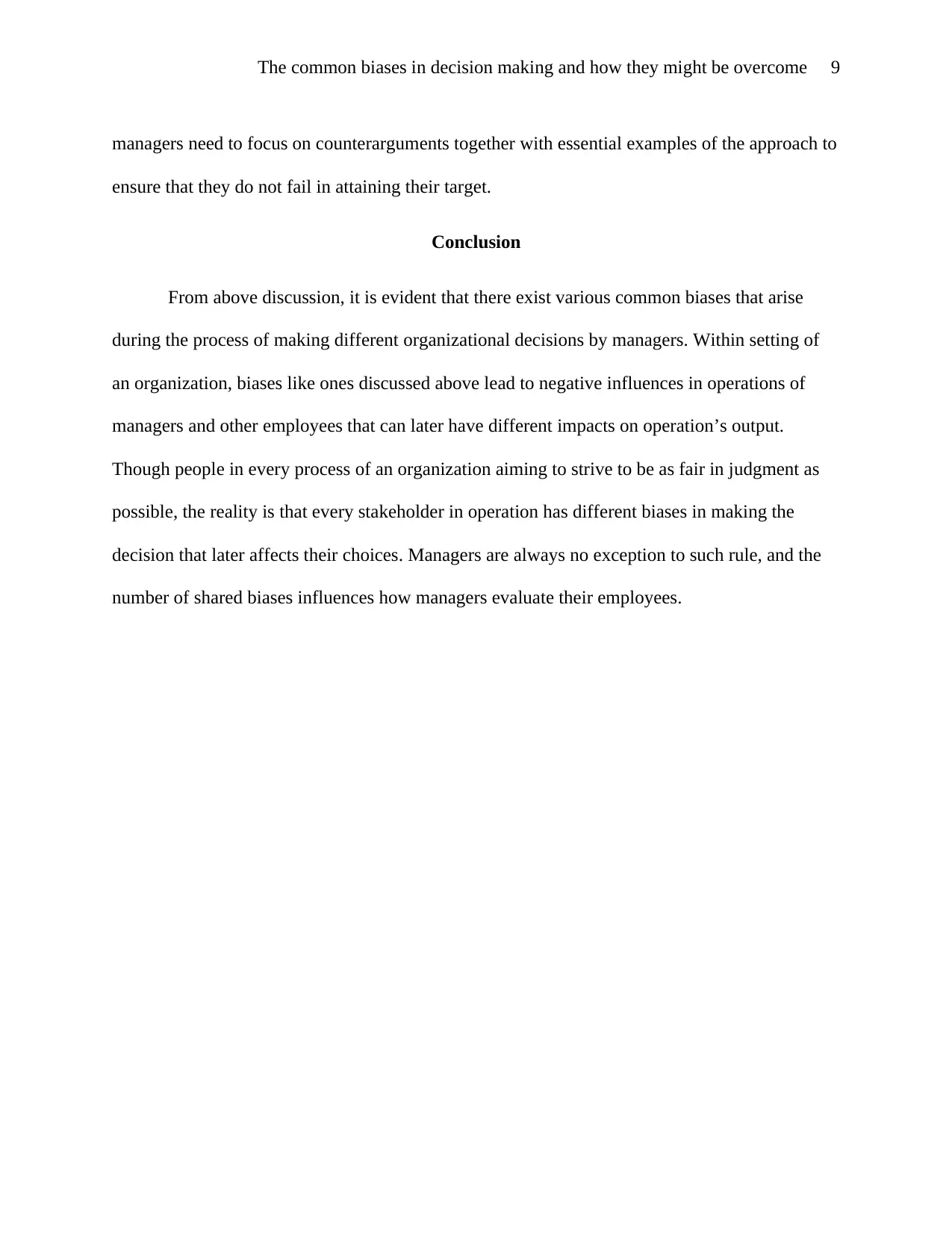
The common biases in decision making and how they might be overcome 9
managers need to focus on counterarguments together with essential examples of the approach to
ensure that they do not fail in attaining their target.
Conclusion
From above discussion, it is evident that there exist various common biases that arise
during the process of making different organizational decisions by managers. Within setting of
an organization, biases like ones discussed above lead to negative influences in operations of
managers and other employees that can later have different impacts on operation’s output.
Though people in every process of an organization aiming to strive to be as fair in judgment as
possible, the reality is that every stakeholder in operation has different biases in making the
decision that later affects their choices. Managers are always no exception to such rule, and the
number of shared biases influences how managers evaluate their employees.
managers need to focus on counterarguments together with essential examples of the approach to
ensure that they do not fail in attaining their target.
Conclusion
From above discussion, it is evident that there exist various common biases that arise
during the process of making different organizational decisions by managers. Within setting of
an organization, biases like ones discussed above lead to negative influences in operations of
managers and other employees that can later have different impacts on operation’s output.
Though people in every process of an organization aiming to strive to be as fair in judgment as
possible, the reality is that every stakeholder in operation has different biases in making the
decision that later affects their choices. Managers are always no exception to such rule, and the
number of shared biases influences how managers evaluate their employees.
⊘ This is a preview!⊘
Do you want full access?
Subscribe today to unlock all pages.

Trusted by 1+ million students worldwide
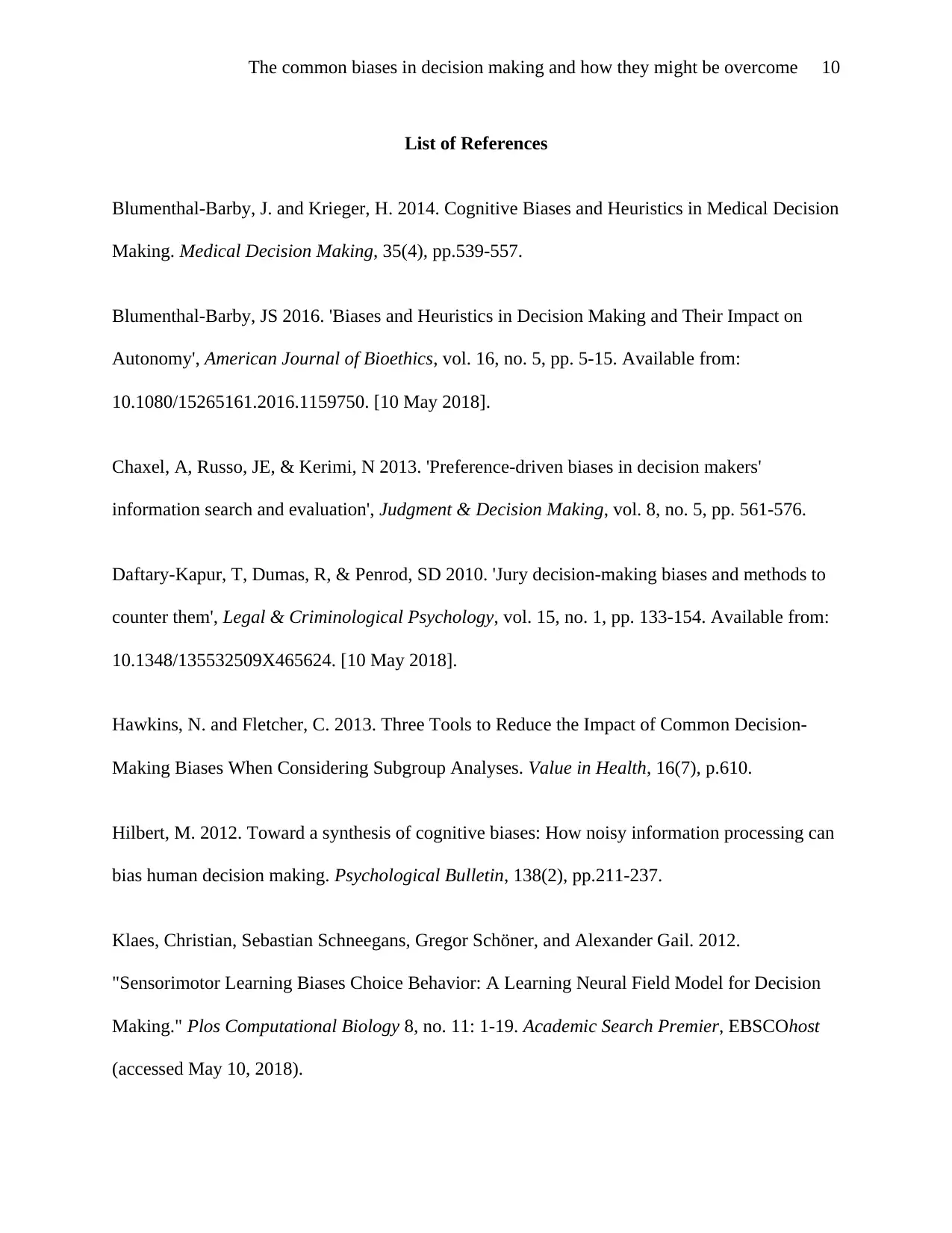
The common biases in decision making and how they might be overcome 10
List of References
Blumenthal-Barby, J. and Krieger, H. 2014. Cognitive Biases and Heuristics in Medical Decision
Making. Medical Decision Making, 35(4), pp.539-557.
Blumenthal-Barby, JS 2016. 'Biases and Heuristics in Decision Making and Their Impact on
Autonomy', American Journal of Bioethics, vol. 16, no. 5, pp. 5-15. Available from:
10.1080/15265161.2016.1159750. [10 May 2018].
Chaxel, A, Russo, JE, & Kerimi, N 2013. 'Preference-driven biases in decision makers'
information search and evaluation', Judgment & Decision Making, vol. 8, no. 5, pp. 561-576.
Daftary-Kapur, T, Dumas, R, & Penrod, SD 2010. 'Jury decision-making biases and methods to
counter them', Legal & Criminological Psychology, vol. 15, no. 1, pp. 133-154. Available from:
10.1348/135532509X465624. [10 May 2018].
Hawkins, N. and Fletcher, C. 2013. Three Tools to Reduce the Impact of Common Decision-
Making Biases When Considering Subgroup Analyses. Value in Health, 16(7), p.610.
Hilbert, M. 2012. Toward a synthesis of cognitive biases: How noisy information processing can
bias human decision making. Psychological Bulletin, 138(2), pp.211-237.
Klaes, Christian, Sebastian Schneegans, Gregor Schöner, and Alexander Gail. 2012.
"Sensorimotor Learning Biases Choice Behavior: A Learning Neural Field Model for Decision
Making." Plos Computational Biology 8, no. 11: 1-19. Academic Search Premier, EBSCOhost
(accessed May 10, 2018).
List of References
Blumenthal-Barby, J. and Krieger, H. 2014. Cognitive Biases and Heuristics in Medical Decision
Making. Medical Decision Making, 35(4), pp.539-557.
Blumenthal-Barby, JS 2016. 'Biases and Heuristics in Decision Making and Their Impact on
Autonomy', American Journal of Bioethics, vol. 16, no. 5, pp. 5-15. Available from:
10.1080/15265161.2016.1159750. [10 May 2018].
Chaxel, A, Russo, JE, & Kerimi, N 2013. 'Preference-driven biases in decision makers'
information search and evaluation', Judgment & Decision Making, vol. 8, no. 5, pp. 561-576.
Daftary-Kapur, T, Dumas, R, & Penrod, SD 2010. 'Jury decision-making biases and methods to
counter them', Legal & Criminological Psychology, vol. 15, no. 1, pp. 133-154. Available from:
10.1348/135532509X465624. [10 May 2018].
Hawkins, N. and Fletcher, C. 2013. Three Tools to Reduce the Impact of Common Decision-
Making Biases When Considering Subgroup Analyses. Value in Health, 16(7), p.610.
Hilbert, M. 2012. Toward a synthesis of cognitive biases: How noisy information processing can
bias human decision making. Psychological Bulletin, 138(2), pp.211-237.
Klaes, Christian, Sebastian Schneegans, Gregor Schöner, and Alexander Gail. 2012.
"Sensorimotor Learning Biases Choice Behavior: A Learning Neural Field Model for Decision
Making." Plos Computational Biology 8, no. 11: 1-19. Academic Search Premier, EBSCOhost
(accessed May 10, 2018).
Paraphrase This Document
Need a fresh take? Get an instant paraphrase of this document with our AI Paraphraser
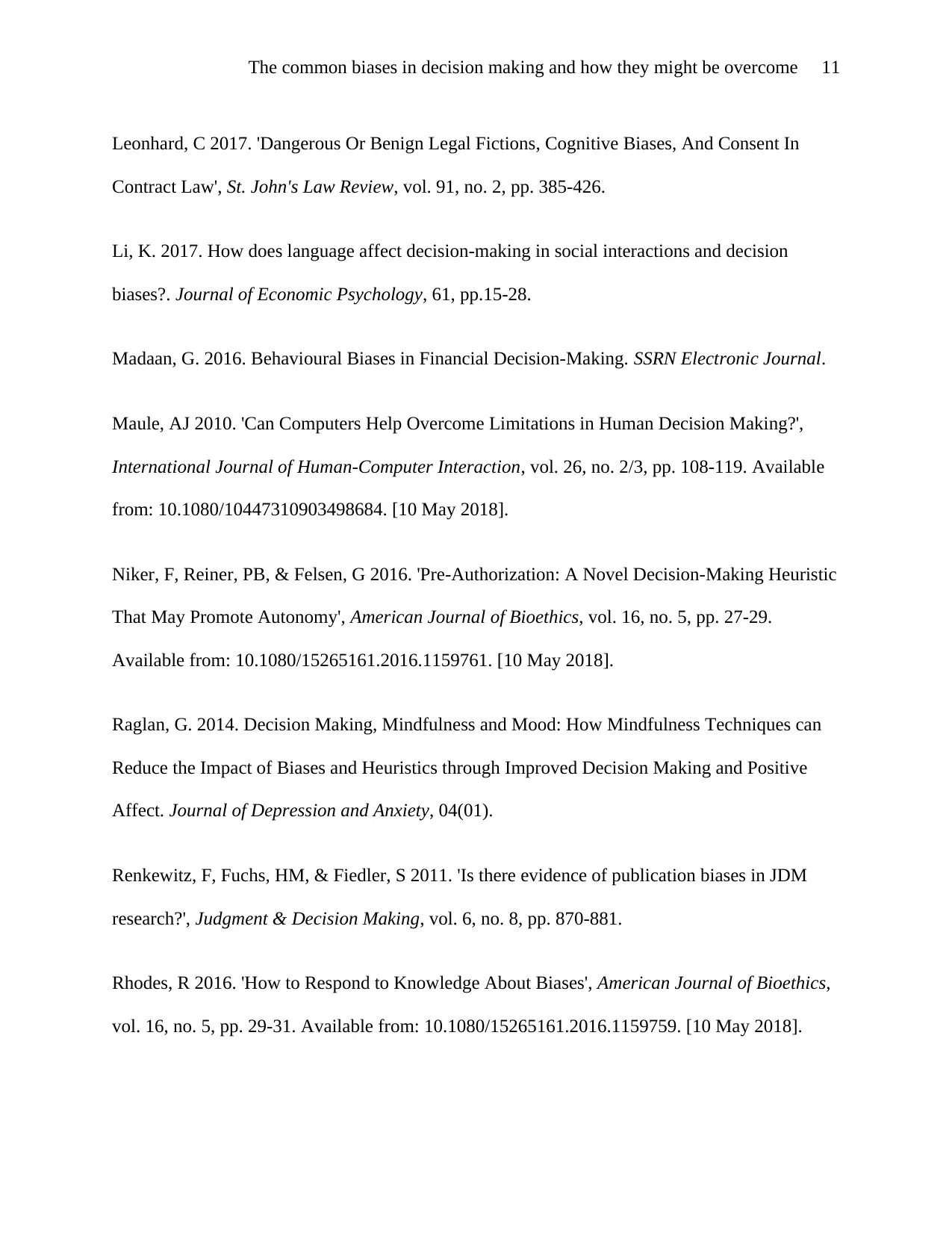
The common biases in decision making and how they might be overcome 11
Leonhard, C 2017. 'Dangerous Or Benign Legal Fictions, Cognitive Biases, And Consent In
Contract Law', St. John's Law Review, vol. 91, no. 2, pp. 385-426.
Li, K. 2017. How does language affect decision-making in social interactions and decision
biases?. Journal of Economic Psychology, 61, pp.15-28.
Madaan, G. 2016. Behavioural Biases in Financial Decision-Making. SSRN Electronic Journal.
Maule, AJ 2010. 'Can Computers Help Overcome Limitations in Human Decision Making?',
International Journal of Human-Computer Interaction, vol. 26, no. 2/3, pp. 108-119. Available
from: 10.1080/10447310903498684. [10 May 2018].
Niker, F, Reiner, PB, & Felsen, G 2016. 'Pre-Authorization: A Novel Decision-Making Heuristic
That May Promote Autonomy', American Journal of Bioethics, vol. 16, no. 5, pp. 27-29.
Available from: 10.1080/15265161.2016.1159761. [10 May 2018].
Raglan, G. 2014. Decision Making, Mindfulness and Mood: How Mindfulness Techniques can
Reduce the Impact of Biases and Heuristics through Improved Decision Making and Positive
Affect. Journal of Depression and Anxiety, 04(01).
Renkewitz, F, Fuchs, HM, & Fiedler, S 2011. 'Is there evidence of publication biases in JDM
research?', Judgment & Decision Making, vol. 6, no. 8, pp. 870-881.
Rhodes, R 2016. 'How to Respond to Knowledge About Biases', American Journal of Bioethics,
vol. 16, no. 5, pp. 29-31. Available from: 10.1080/15265161.2016.1159759. [10 May 2018].
Leonhard, C 2017. 'Dangerous Or Benign Legal Fictions, Cognitive Biases, And Consent In
Contract Law', St. John's Law Review, vol. 91, no. 2, pp. 385-426.
Li, K. 2017. How does language affect decision-making in social interactions and decision
biases?. Journal of Economic Psychology, 61, pp.15-28.
Madaan, G. 2016. Behavioural Biases in Financial Decision-Making. SSRN Electronic Journal.
Maule, AJ 2010. 'Can Computers Help Overcome Limitations in Human Decision Making?',
International Journal of Human-Computer Interaction, vol. 26, no. 2/3, pp. 108-119. Available
from: 10.1080/10447310903498684. [10 May 2018].
Niker, F, Reiner, PB, & Felsen, G 2016. 'Pre-Authorization: A Novel Decision-Making Heuristic
That May Promote Autonomy', American Journal of Bioethics, vol. 16, no. 5, pp. 27-29.
Available from: 10.1080/15265161.2016.1159761. [10 May 2018].
Raglan, G. 2014. Decision Making, Mindfulness and Mood: How Mindfulness Techniques can
Reduce the Impact of Biases and Heuristics through Improved Decision Making and Positive
Affect. Journal of Depression and Anxiety, 04(01).
Renkewitz, F, Fuchs, HM, & Fiedler, S 2011. 'Is there evidence of publication biases in JDM
research?', Judgment & Decision Making, vol. 6, no. 8, pp. 870-881.
Rhodes, R 2016. 'How to Respond to Knowledge About Biases', American Journal of Bioethics,
vol. 16, no. 5, pp. 29-31. Available from: 10.1080/15265161.2016.1159759. [10 May 2018].
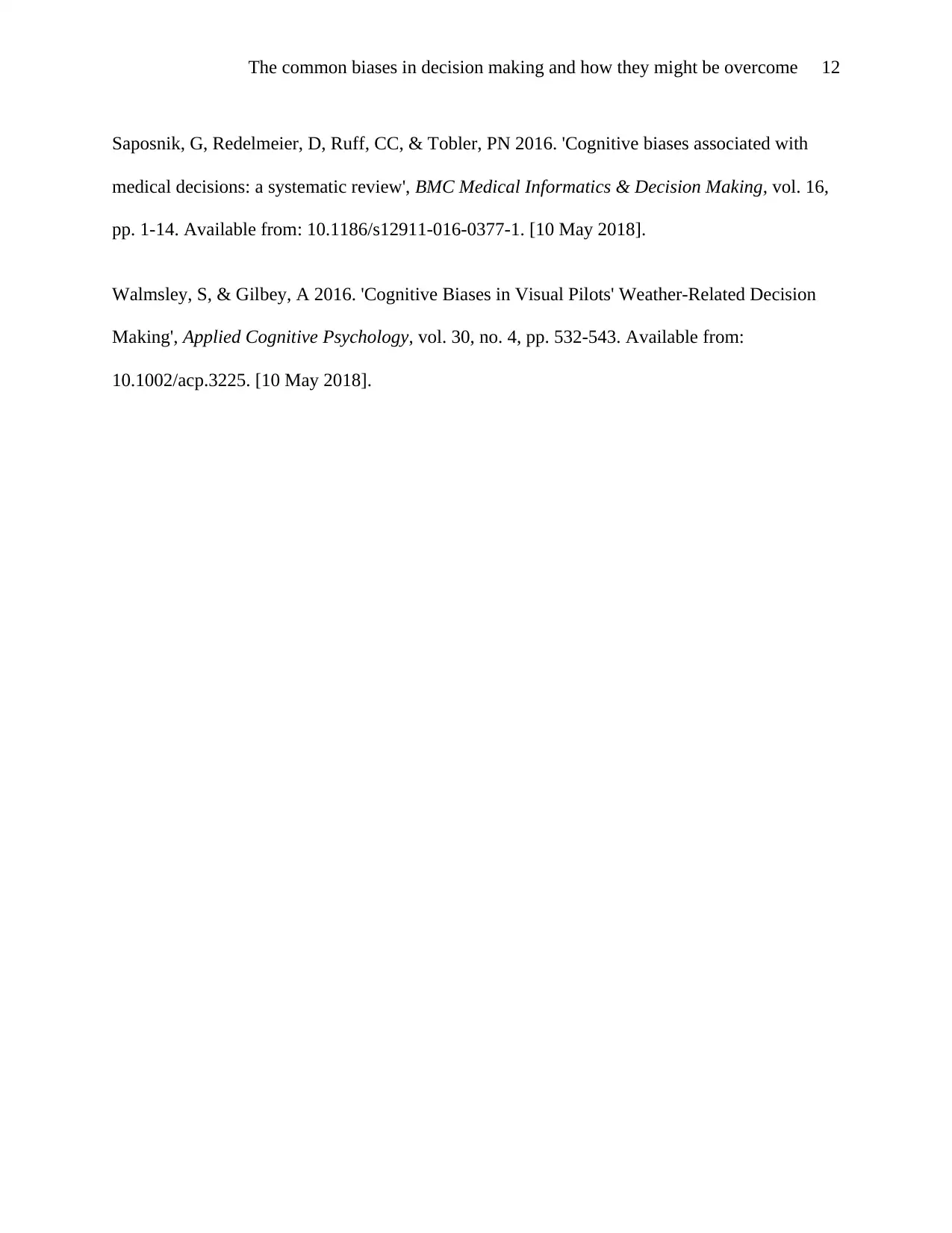
The common biases in decision making and how they might be overcome 12
Saposnik, G, Redelmeier, D, Ruff, CC, & Tobler, PN 2016. 'Cognitive biases associated with
medical decisions: a systematic review', BMC Medical Informatics & Decision Making, vol. 16,
pp. 1-14. Available from: 10.1186/s12911-016-0377-1. [10 May 2018].
Walmsley, S, & Gilbey, A 2016. 'Cognitive Biases in Visual Pilots' Weather-Related Decision
Making', Applied Cognitive Psychology, vol. 30, no. 4, pp. 532-543. Available from:
10.1002/acp.3225. [10 May 2018].
Saposnik, G, Redelmeier, D, Ruff, CC, & Tobler, PN 2016. 'Cognitive biases associated with
medical decisions: a systematic review', BMC Medical Informatics & Decision Making, vol. 16,
pp. 1-14. Available from: 10.1186/s12911-016-0377-1. [10 May 2018].
Walmsley, S, & Gilbey, A 2016. 'Cognitive Biases in Visual Pilots' Weather-Related Decision
Making', Applied Cognitive Psychology, vol. 30, no. 4, pp. 532-543. Available from:
10.1002/acp.3225. [10 May 2018].
⊘ This is a preview!⊘
Do you want full access?
Subscribe today to unlock all pages.

Trusted by 1+ million students worldwide
1 out of 12
Related Documents
Your All-in-One AI-Powered Toolkit for Academic Success.
+13062052269
info@desklib.com
Available 24*7 on WhatsApp / Email
![[object Object]](/_next/static/media/star-bottom.7253800d.svg)
Unlock your academic potential
Copyright © 2020–2025 A2Z Services. All Rights Reserved. Developed and managed by ZUCOL.




